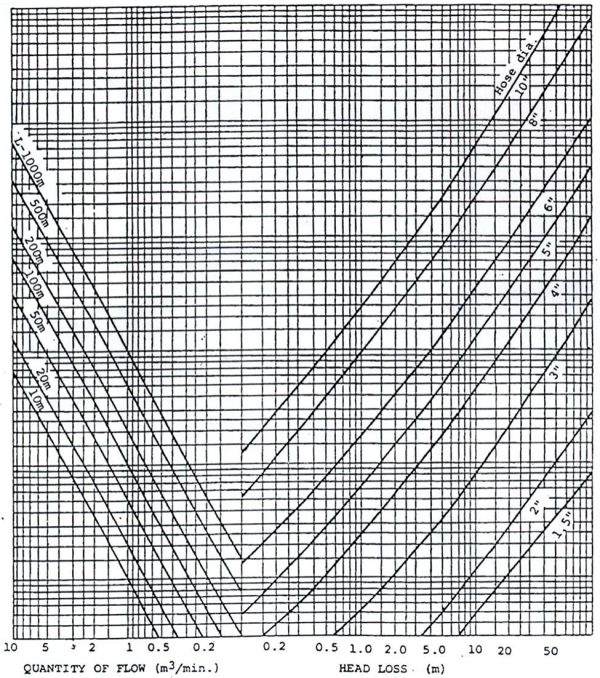Pressure Drop in Hoses
The following tables of pressure drops and flow rates are based on experimental data and may be considered typical of most hoses. The data is based upon hoses laid out in a straight line and thus it must not be considered as an exact result that may be obtained at a given pressure. Variables such as hose fittings and bends increase the frictional losses and an estimate of their effect may be determined by adding an “equivalent length” to the hose length. Values of the equivalent length (Le) may be determined using the inside diameter (D) of the hose in the following relationships:
- 90° swept elbow – Le = 20D
- 90° square elbow – Le = 50D
- 45° square elbow – Le = 16D
- Hose coupling – Le = 5D
| Pressure Drop (kPa/100m) Water at 20°C Through Hose | |||||||||||||
|---|---|---|---|---|---|---|---|---|---|---|---|---|---|
| Flowrate 1/m | Hose Internal Diameter | ||||||||||||
| 12.5 | 16 | 19 | 25 | 32 | 38 | 40 | 50 | 64 | 75 | 80 | 100 | 125 | |
| 25 | 1100 | 470 | 210 | 50 | - | - | - | - | - | - | - | - | - |
| 50 | - | 2440 | 770 | 200 | 90 | 30 | - | - | - | - | - | - | - |
| 100 | - | - | 2260 | 730 | 300 | 100 | 55 | 30 | - | - | - | - | - |
| 200 | - | - | - | - | 1030 | 405 | 285 | 95 | 25 | - | - | - | - |
| 300 | - | - | - | - | - | 900 | 650 | 210 | 65 | 20 | - | - | - |
| 400 | - | - | - | - | - | - | 1200 | 370 | 110 | 40 | - | - | - |
| 500 | - | - | - | - | - | - | - | 580 | 155 | 70 | 50 | - | - |
| 1000 | - | - | - | - | - | - | - | - | 575 | 230 | 180 | 55 | - |
| 2000 | - | - | - | - | - | - | - | - | - | 920 | 600 | 220 | 45 |
| 3000 | - | - | - | - | - | - | - | - | - | 2125 | 1400 | 490 | 100 |
| 4000 | - | - | - | - | - | - | - | - | - | - | - | 805 | 190 |
| 5000 | - | - | - | - | - | - | - | - | - | - | - | 1390 | 315 |
- NOTE:(1) Pressure drop is directly proportioned to the length of hose.
- (2) Friction is independent of pressure and proportional to velocity.
Pressure Drop of Air Through Rubber Hoses
| SIZE (MM) | CU./M OF FREE AIR | |||||||
|---|---|---|---|---|---|---|---|---|
| 0.5 | 1 | 1.25 | 1.5 | 2 | 2.75 | 3.5 | 4.25 | |
| 12.5 | 249 | 855 | 1325 | - | - | - | - | - |
| 19 | - | 215 | 350 | 505 | 895 | 1725 | 2745 | - |
| 25 | - | - | - | - | 250 | 465 | 755 | 1100 |
| 32 | - | - | - | - | 80 | 100 | 175 | 285 |
| 38 | - | - | - | - | - | 45 | 75 | 135 |
| Size (mm) | Cu./m of Free Air | |||||||||||
|---|---|---|---|---|---|---|---|---|---|---|---|---|
| - | 15 | 20 | 30 | 40 | 50 | 60 | 70 | 80 | 90 | 100 | 125 | 150 |
| 50 | 385 | 680 | 1530 | 2690 | 4230 | - | - | - | - | - | - | - |
| 64 | 160 | 270 | 565 | 1020 | 1630 | 2350 | 3170 | 4185 | 5270 | - | - | - |
| 76 | - | - | 215 | 330 | 520 | 745 | 1020 | 1335 | 1675 | 2035 | 3190 | 4590 |
To obtain frictional pressure loss in kPa/100m divide above values by the ratio of compression listed here:
| KPA W.P. | RATIO OF COMPRESSION |
|---|---|
| 400 | 3.9 |
| 500 | 4.9 |
| 600 | 5.9 |
| 700 | 6.9 |
| 800 | 7.85 |
| 900 | 8.85 |
| 1000 | 9.85 |
Pressure Loss - Layflat Hose

NPE provides these calculators and guides to assist with general queries and recommends working with experts to ensure suitability.
NPE assumes no responsibility or liability for any errors, omissions or misuse of the contents of this site. These online tools do not constitute professional advice.
For assistance, contact any of NPE’s Australian branches.
